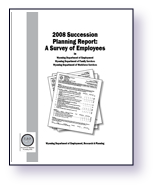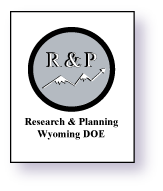Chapter 6: Turnover and Labor Market Context
by: Dr. Mark A. Harris, Sociologist
This section uses administrative data available to R&P to capture employment and turnover statistics and defines the labor market in which the Department of Family Services (DFS), Department of Employment (DOE), and Department of Workforce Services (DWS) function. The data describe what has happened in the recent past. In the future, turnover and source/destination data could be used to ascertain the overall effect of policy changes intended to alter the workplace (e.g., “what happened to the exit rate in our agency after we did X?”) or in understanding how market forces beyond the control of the agency influence the hire or exit rate (e.g., “how is competition from the energy boom affecting our ability to retain employees?”).
Data
Data used for this section included Unemployment Insurance (UI) wage records for Wyoming and partner research states (discussed below) and the Wyoming Quarterly Census of Employment and Wages (QCEW). The UI wage records describe a person’s work history and employers, while the QCEW identifies the employer’s industry and ownership.
Method
The method for tracking state employees was developed previously (Harris, 2006). The source and destination time-frame was limited to the four quarters prior to and after the quarter in which a state employee was hired or exited, and was defined as the employer paying the highest wages. In cases where state employees were not employed prior to being hired or after exiting, they were categorized as not working.
Category Definitions
The category of partner research state, for purposes of this analysis, includes Alaska, Colorado, Idaho, Montana, Nebraska, New Mexico, South Dakota, and Utah. All states bordering Wyoming were included. No report was made of the industry or ownership status of the out-of-state firms in question.
Wyoming resident status (Resident and Non-Resident) is determined by a methodology developed by Jones (2004). Residency status applies during the quarter in which a state employee was hired or exited. Retirement refers to Wyoming residents who were 65 or older. Government included establishments that were publicly owned. The category of private sector represents Wyoming privately owned establishments.
Number of Jobs Worked
Figure 1 presents job counts for all three state agencies from first quarter 2004 to fourth quarter 2007. A four-quarter moving average is used to reduce seasonal variation and to provide a better picture of the overall trend in job growth or decline. DOE typically maintained between 310 and 320 jobs on an average quarterly basis throughout the 16 quarters. DFS experienced steady growth in the number of jobs worked throughout the 16-quarter time-frame. The agency grew from just fewer than under 760 jobs to slightly more than 780 jobs on an average quarterly basis. On the other hand, DWS declined in the number of jobs worked on an average quarterly basis from nearly 280 jobs to approximately 255 jobs by the end of the time frame.
Hire Rate
The hire rate was calculated as the number of hires (see Glover, 2001, for definition of hires and exits) in the reference quarter divided by the total number of jobs in the same quarter and expressed as a percentage. Figure 2 shows the four-quarter moving average hire rate for first quarter 2004 to fourth quarter 2007. To provide a comparison to the performance of all executive branch state agencies, the hire rate for the executive branch is included. The hire rate for all executive branch agencies was approximately 6.0% on an average quarterly basis and was very stable for the entire time frame. DOE had the lowest hire rate of the three separate agencies considered here, approximately 3.0%. This is substantially lower than the rate for all executive branch agencies combined. The hire rate for the DWS vacillated around 6.0% until fourth quarter 2006, when it dropped dramatically to approximately 4.0% and remained there through the end of the time frame. The hire rate for DFS trended upward throughout this time, increasing from approximately 4.0% to approximately 5.0%.
Source of Employee Hires
The source of employee hires was defined as the most recent employer (looking at previous employment up to a maximum of one year prior to the reference quarter) that paid the most wages. When there was no employment history in the previous year, other information was used to categorize the hire where possible. For example, those without a work history in the prior year were divided into residents and nonresidents at the time of hire (see Jones, 2004, for resident/nonresident methodology).
Figure 3 presents source of hire information for 2003Q1 to 2007Q4. Not all findings shown in Figure 3 will be discussed in this section. The major finding of this exercise indicates that the source of hires for executive branch agencies is primarily dominated (more than 50.0% for each of the three agencies under study) by private sector employers in Wyoming. This held true for all three agencies under study. A specific example of this would be someone hired into DOE who worked previously in retail trade in Wyoming. It should be noted that there are substantial variations in the source of employee hires for the three agencies under study. For instance, DOE had a larger percentage of hires who came from other state government agencies than DFS or DWS. Very few hires were individuals who were presumed to be retired (i.e., no previous work history in the last year and older than age 62).
Exit Rates
The exit rate was calculated as the number of exits in the reference quarter divided by the total number of jobs in the same quarter and expressed as a percentage. Figure 4 shows the four-quarter moving average exit rate for the period 2004Q1 through 2007Q3. The exit rate for the executive branch remained steady throughout the time-frame at around 4.5% on an average quarterly basis. The rate for DFS was similar but trended above the executive branch rate after 2006Q3. The exit rate for DWS was dramatically higher (typically above 6.0 percent) until 2006Q2. After 2006Q2 the rate dropped each quarter until leveling off near 4.5% during 2007Q2. The exit rate for the DOE was consistently below the rate for the executive branch throughout the time-frame under study. The rate was at or below 3.0% after 2006Q1.
Destination of Employee Exits
The destination of employee exits is defined as the most recent employer (looking at subsequent employment up to a maximum of one year after to the reference quarter) that paid the most wages. When there is no employment history in the subsequent year, other information is employed to categorize the hire where possible. Approximately 40.0% of employees obtained primary employment in the private sector after exiting from the three state agencies under study (see Figure 5, page 35). About 20.0% from DOE and DWS obtained employment in another state agency. Approximately 10.0% of DFS exiting employees obtained work in another state government agency—the lowest of the three agencies under study. The DFS exiters were somewhat more likely to find subsequent work in a partner research state or a local government entity (e.g., a city or county).
Private Sector Breakdown
Figure 6 is an extension of Figure 5. It provides more specific detail on the exiters who subsequently obtained work in the private sector. This graphic provides greater detail on the private sector North American Industry Classification System (NAICS) industries that compete for labor with the three state agencies under study here. There is substantial variation in the industry breakdown of state employee exiters. Most notably are natural resources & mining and health services. Approximately 40.0% of the exiters from DOE who went into the private sector ended up working in natural resources & mining. DWS and DFS had fewer than 5.0% of exiters in this NAICS category. DFS had more than 30.0% of exiters subsequently working in health services. The DOE had fewer than 5.0% of exiters working in this category. DWS, of the three agencies, had the greatest percentage of exiters working in retail trade and leisure & hospitality.
Observations
DOE remained about the same in terms of the number of jobs and had a declining hire rate and a declining exit rate for the period under study. DOE appears to be a very stable agency in terms of both size and turnover activity. Hire and exit rates were both well below those for the entire executive branch.
DWS appears to be trending downward in size – losing approximately 25 jobs worked on an average quarterly basis during the study period. DWS experienced very high hire and exit rates (in comparison to all executive branch agencies) earlier in the time frame but had a dramatic drop in turnover activity after fourth quarter 2006 with exit rates ending up at approximately the same level (slightly higher than 4.0% on an average quarterly basis) as for all executive branch agencies by the end of the time frame. DWS appeared to be becoming a smaller and more stable agency.
DFS grew in the number of jobs worked over the course of the study period. It also had increasing hire and exit rates throughout the study period. With exit rates exceeding those for the entire executive branch after third quarter 2006, DFS grew but had less employment stability over time.
All three state agencies appeared to be strongly tied to Wyoming’s labor market, hiring from and losing exiters to private sector employers in the state. Other agencies within state government and local government entities also form a substantial portion of the market for hires and exits among the three agencies. Fewer than 10.0% of hires or exits involved a partner research state.
References
Glover, W. (2001). Turnover analysis: Definitions, process, and quantifications. Retrieved July 18, 2008, from http://doe.state.wy.us/LMI/w_r_research/Turnover_Methodology.pdf
Harris, M. A. (2006). Where do they come from and where do they go: Wyoming employers compete for older workers. Wyoming Labor Force Trends 43(12). Retrieved July 18, 2008, from http://doe.state.wy.us/LMI/1206/a1.htm
Jones, S. D. (2004). Worker residency determination, Wyoming stepwise procedure. Retrieved July 18, 2008, from http://doe.state.wy.us/LMI/0804/a1supp.htm

